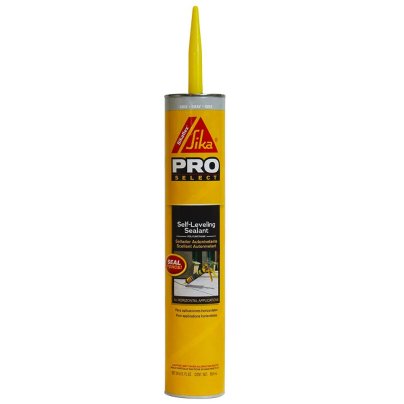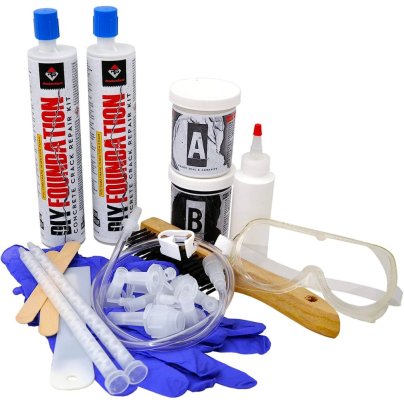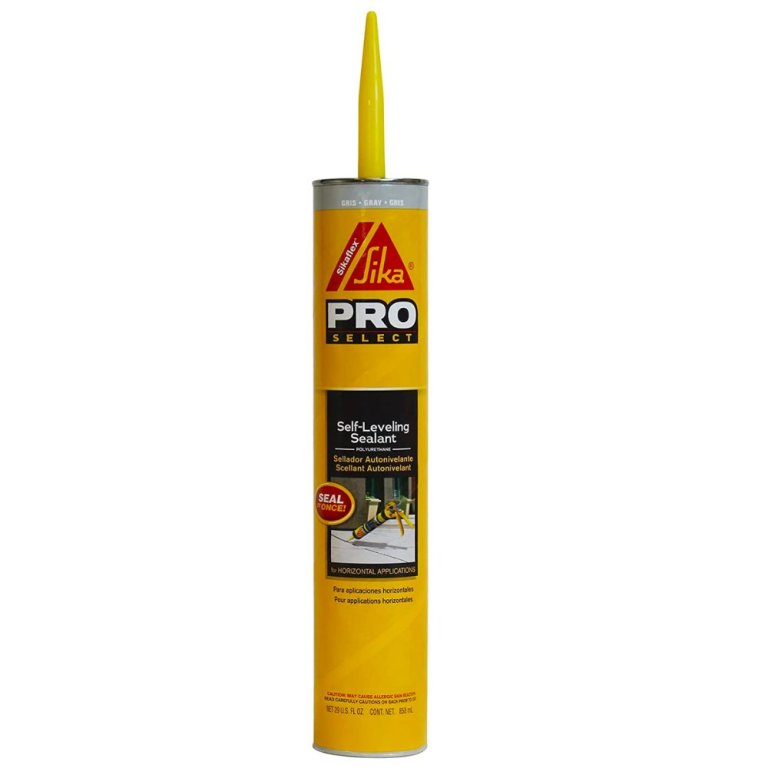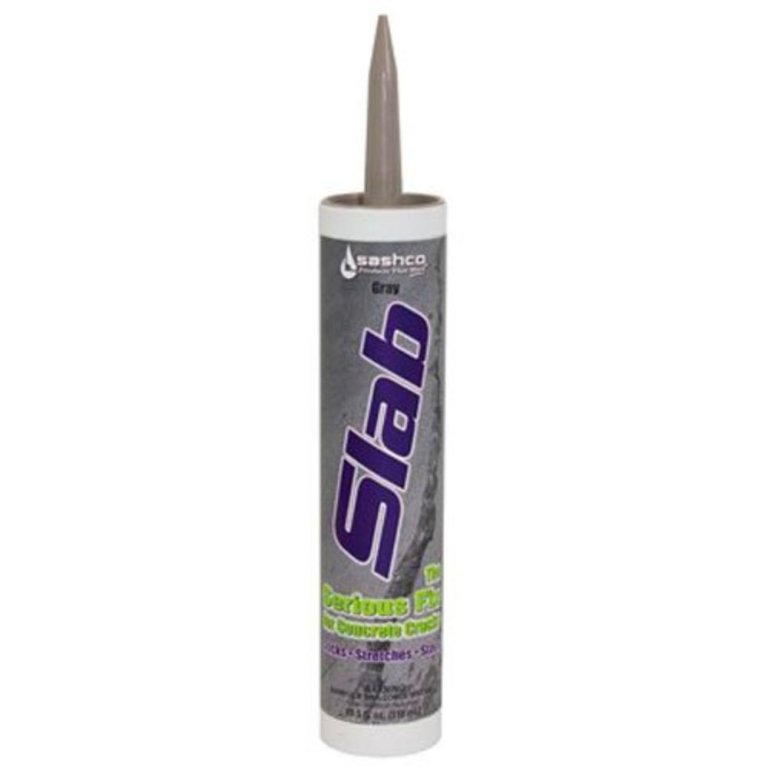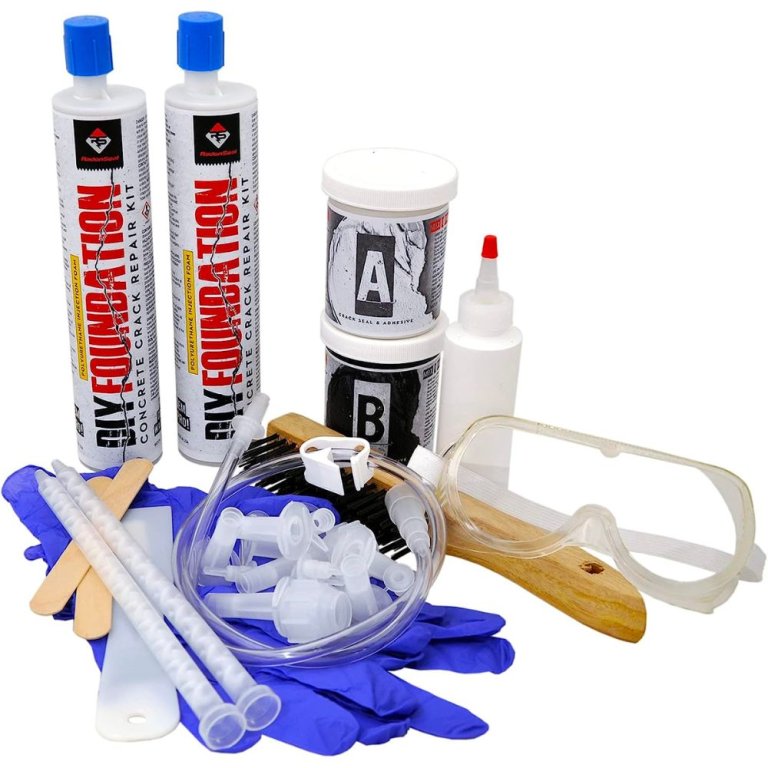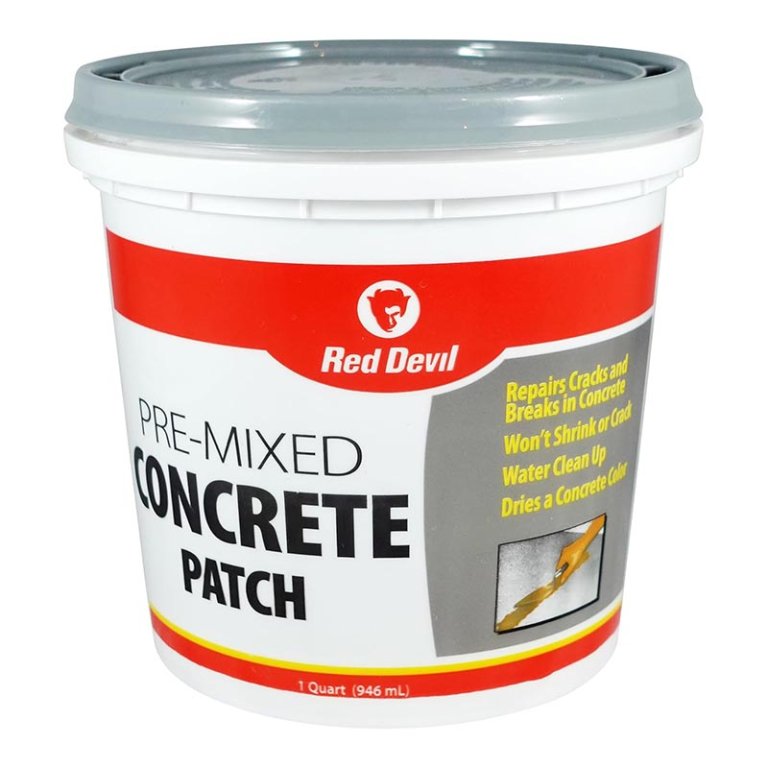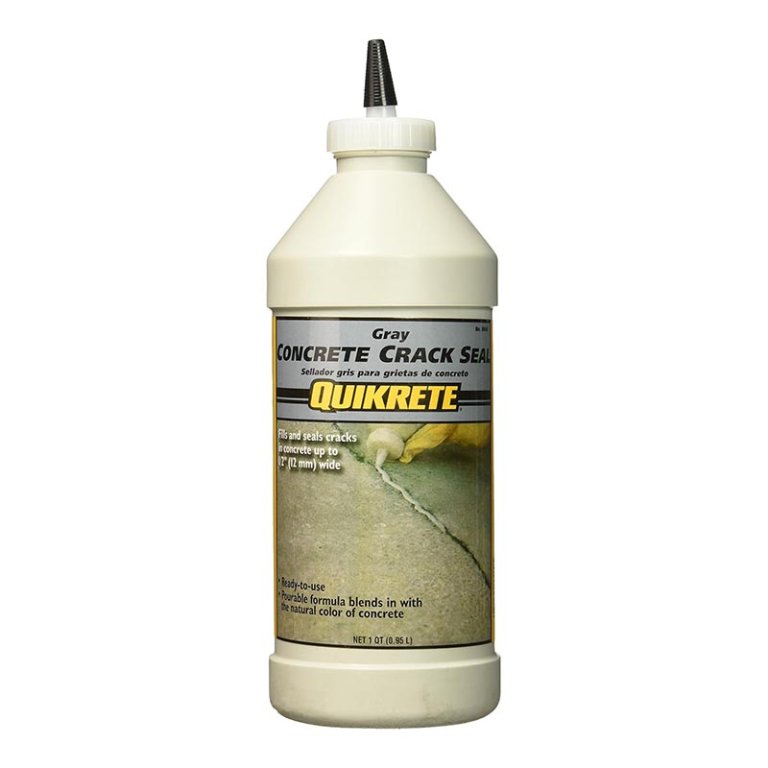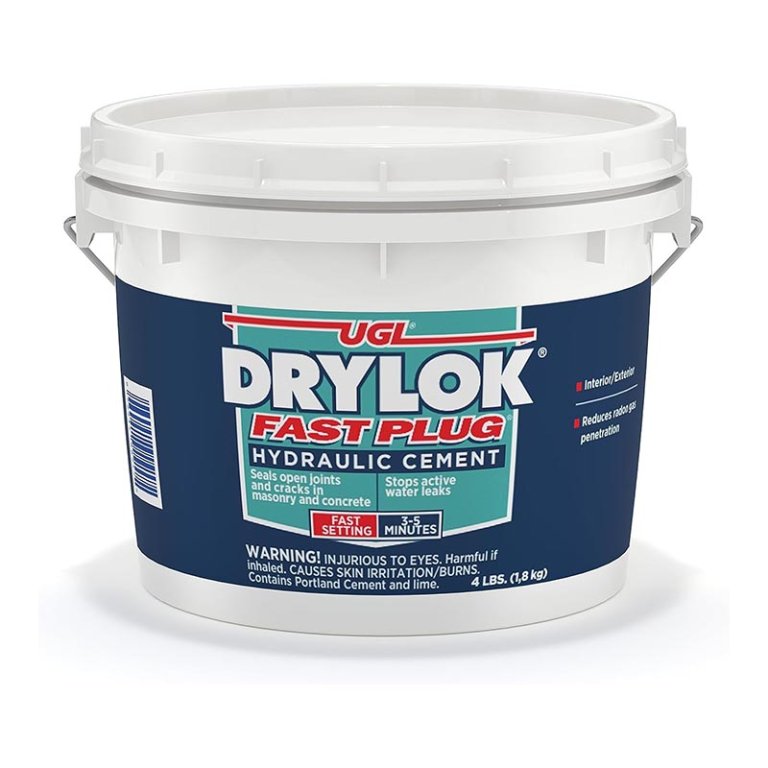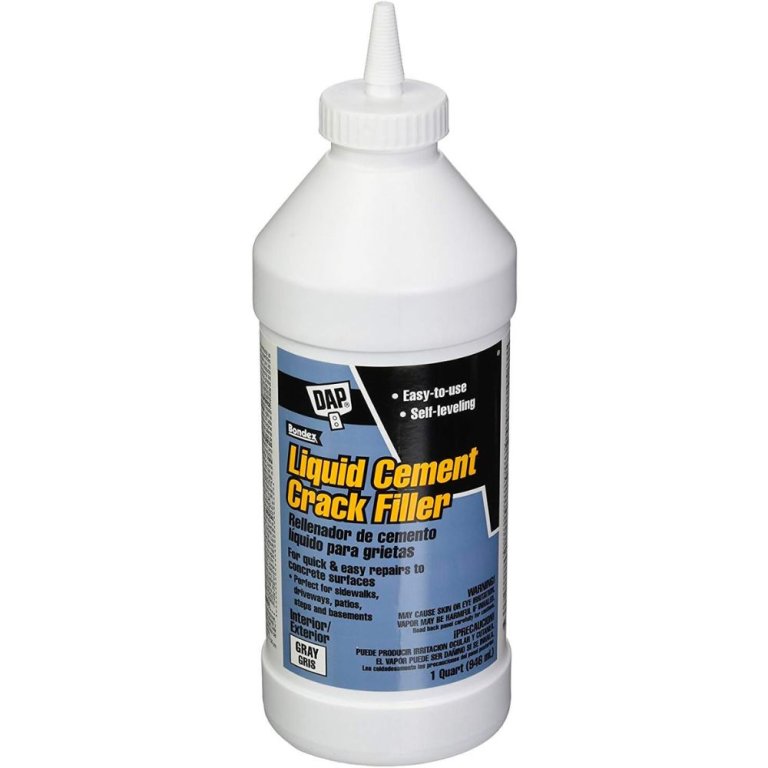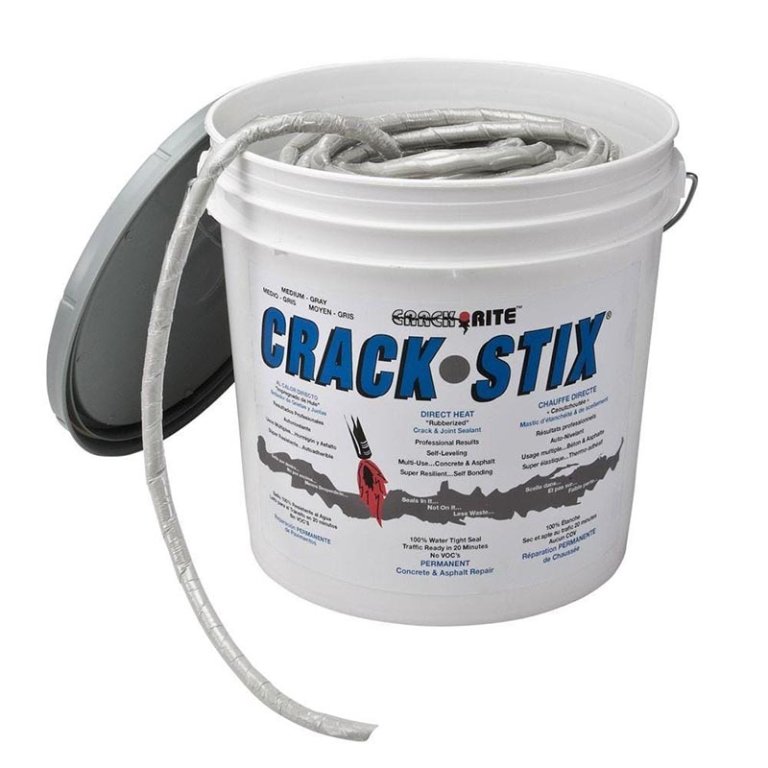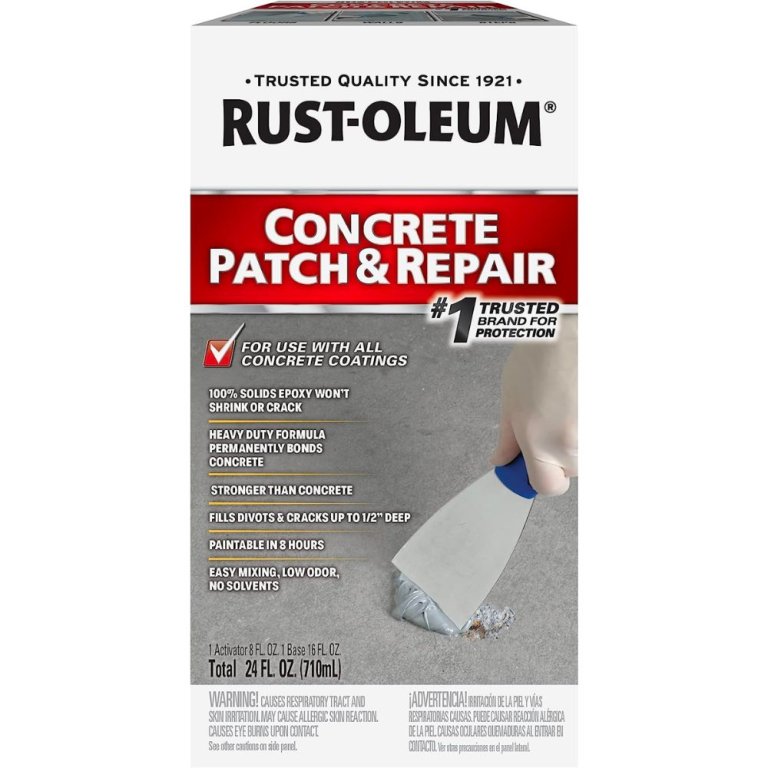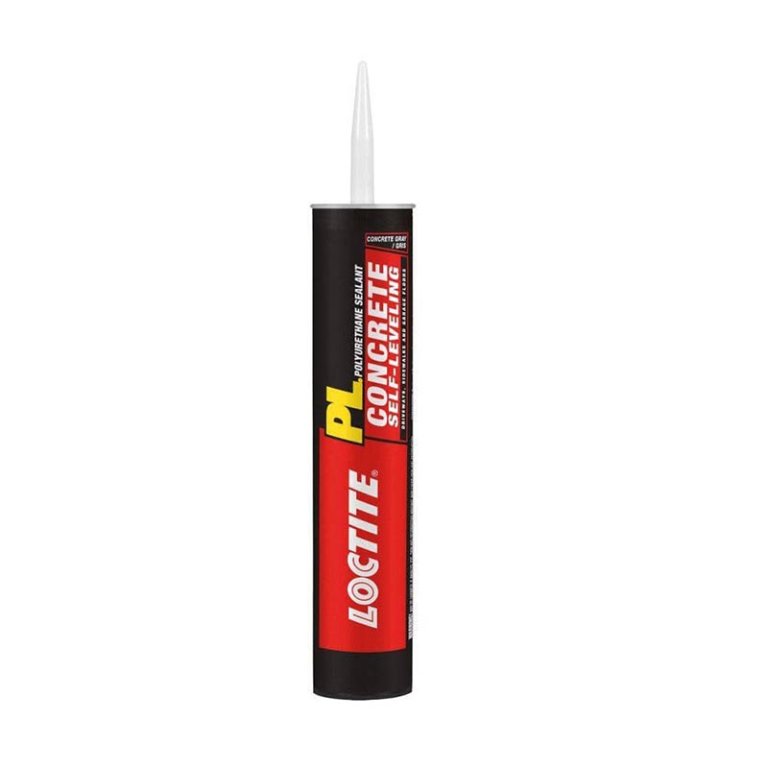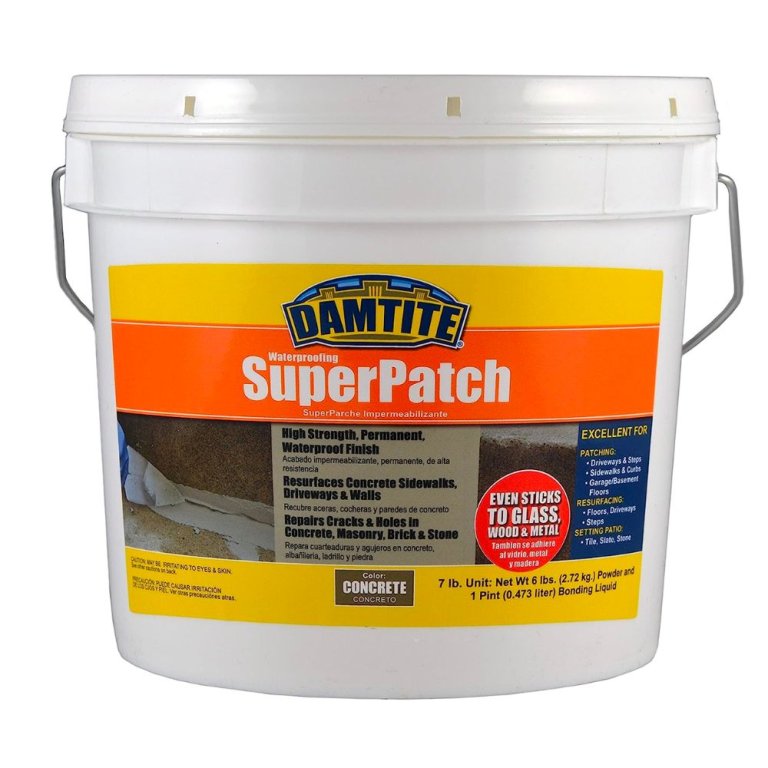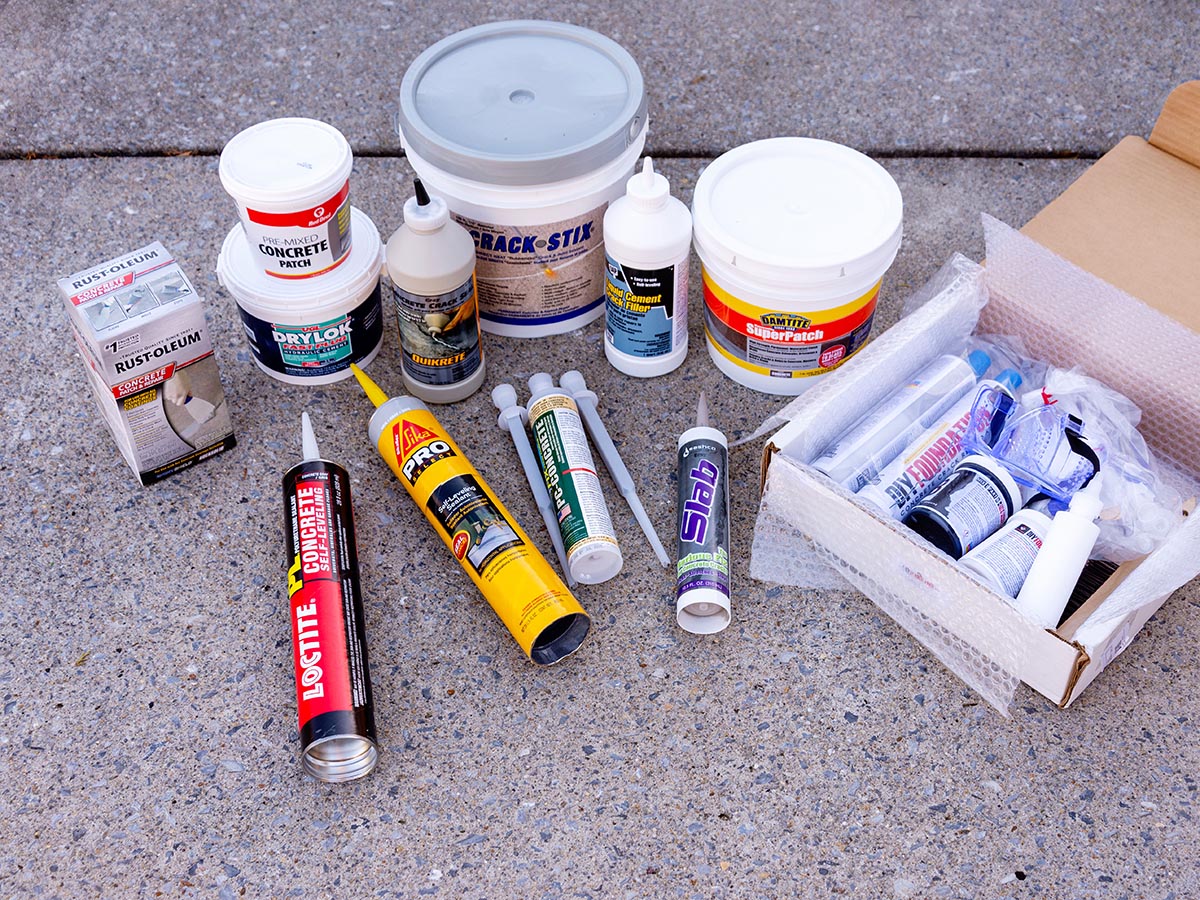
We may earn revenue from the products available on this page and participate in affiliate programs. Learn More ›
Though incredibly stable and durable, concrete is not indestructible, and that’s where concrete crack fillers can make a difference. Cracks can develop for a variety of reasons, including natural causes, physical damage, poor design, and more. For the long-term performance and safety of the slab or wall, and to keep the damage from spreading further, it is important to repair any cracks promptly. Fillers repair cracks in foundations, driveways, sidewalks, and basement walls, improving the look and longevity of the wall or slab.
We researched more than a dozen epoxy, polyurethane, polymers, liquid concrete, and other types, and then tested some of the most highly rated products available. In the process, we learned that surface orientation, crack size, weather exposure, and other variables can help guide a DIYer’s decision regarding concrete repairs. In our tests, we liked the Sikaflex Self-Leveling Sealant best for its smooth, drip-free application.
That said, it’s not the only product that does a great job. Read on to find out why these products made our list of best concrete crack fillers and discover what to look for when choosing a product for your repairs.
- BEST OVERALL: Sikaflex Self-Leveling Sealant
- BEST BANG FOR THE BUCK: Sashco Slab Concrete Crack Filler
- BEST FOR FOUNDATIONS: RadonSeal DIY Foundation Crack Repair Kit
- BEST FOR LARGE CRACKS: Red Devil Premixed Concrete Patch
- BEST FOR THIN CRACKS: Quikrete Concrete Crack Seal
- BEST DRYING TIME: UGL Drylok Fast Plug Hydraulic Cement
- BEST EPOXY: PC-Concrete Anchoring and Crack-Filling Epoxy
- BEST LIQUID: DAP Liquid Cement Crack Filler
- BEST FLEXIBLE: Crack Stix Permanent Concrete Joint & Crack Filler
- BEST MULTIPURPOSE: Rust-Oleum Concrete Patch & Repair
- BEST SELF-LEVELING: Loctite PL Self-Leveling Concrete Sealant
- ALSO CONSIDER: Damtite Waterproofing SuperPatch
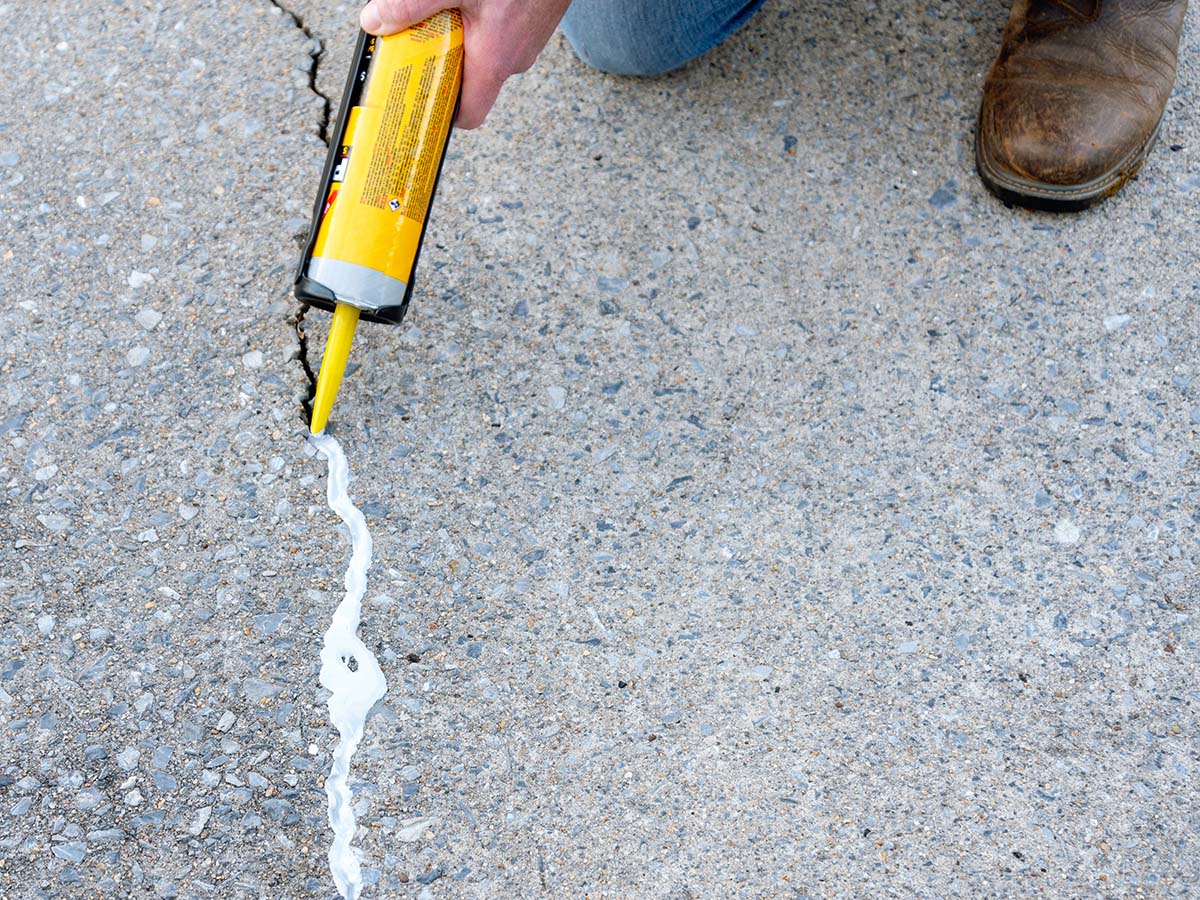
How We Tested the Best Concrete Crack Fillers
Most of the products we tested were designed specifically for crack repairs in horizontal surfaces, from hairline cracks to openings as wide as 3 inches. A few others can be used to repair cracks on vertical surfaces, and most are rated for both indoor and outdoor use. Some repair aesthetic damage, while others are rated for structural repairs. Our tests focused on application locations and methods, tooling requirements, cure time, and paintability.
For horizontal crack tests, we followed the manufacturers’ instructions while patching up cracks in a concrete driveway. Each product filled a minimum of 4 linear feet of cracks, with widths ranging from hairline to ¾ inch. For vertical cracks, we filled cracks in a poured basement wall. We evaluated each product according to ease of use, ease of cleanup, cure time, finished appearance, and paintability, then scored them on a scale of 1 (worst) to 5 (best) in each category. In the reviews ahead, we share our reasons for selecting each product and our observations from testing.
Our Top Picks
Concrete crack fillers can make an unsightly crack a distant memory in just one afternoon. We spent 2 weeks researching and testing the following products. Each was fast and easy to use and left behind a smooth, attractive surface after repairs were complete. Read on to find out how each product excels and if it might be right for your project.
Best Overall
Sikaflex Self-Leveling Sealant
Pros
- Easy to use; simply caulk the sealant into the crack and wait 3 to 5 days
- Ready-made mixture for convenience and user-friendliness
- Ideal for multiple concrete applications
Cons
- Long curing time compared with some alternative products
Product Specs
- Available sizes: 10.1 ounces and 29 ounces
- Curing time: 3 to 5 days
- Application: Caulking gun
Our Ratings: Ease of Use 5/5; Cleanup 5/5; Fast Results 3/5; Appearance 5/5; Paintability 5/5
Whether it’s a small crack or a wide gap, Sikaflex self-leveling sealant is up to the task. This product can fill gaps up to 1.5 inches wide with ease on such horizontal surfaces as garage floors, walkways, and patios. Once fully cured, it remains flexible as well as entirely submersible, making it suitable for pool repairs or other areas exposed to water. Sikaflex comes in 10.1-ounce containers that fit standard caulking guns, or 29-ounce tubes that require an XL caulking gun. Simply squeeze the product into the crack and thanks to its self-leveling quality, little to no tool work will be necessary for a uniform finish. Fully cured Sikaflex can be painted, stained, or sanded to your desired finish.
We awarded Sikaflex sealant the top spot because it was so affordable, effective, and easy to use, even though it took a bit longer to cure than other options. We tested the XL size, and it delivered excellent results. Since the air temperature was 45 degrees during application, we allowed the tube to come to room temperature indoors for a couple of hours to make it more pliable. It went on smoothly with average hand pressure and no drips. It settled neatly into the cracks and formed a tack-free skin after a few hours. Full cure took 5 days in our cool temperatures, which was longer than most of the other products we tested.
Get the Sikaflex concrete crack filler at Amazon, Lowe’s, The Home Depot, or Walmart (10.1 ounces).
Best Bang for the Buck
Sashco Slab Concrete Crack Filler
Pros
- Easy to apply; simply caulk the sealant into any cracks on the driveway
- Can be used on a variety of surfaces, including sidewalks, patios, driveways, and more
- Ideal for gaps of up to 3 inches
Cons
- 1 week cure time is quite long compared with similar options
- Not be suitable for vertical applications
Product Specs
- Available sizes: 10.5 ounces
- Curing time: 1 week
- Application: Caulking gun
Our Ratings: Ease of Use 5/5; Cleanup 4/5; Fast Results 3/5; Appearance 5/5; Paintability 5/5
Sashco’s cost-effective concrete filler is all about flexibility, stretching up to three times the width of the cracks it repairs. This sealant can handle cracks up to 3 inches wide on sidewalks, patios, driveways, floors, and other horizontal concrete surfaces. This 10-ounce concrete crack filler fits in a standard caulking gun and flows easily, allowing users to squeeze it into small or large cracks without needing to use trowels or putty knives. Once cured, it remains elastic and flexible, preventing further damage from freeze-thaw cycles. This concrete crack repair is also paintable, so you can blend the repair joint with the rest of the concrete surface.
Sashco Slab concrete crack filler came in a smaller package than our 29-ounce top pick, but it proved its usefulness in repairing larger cracks. We used up the entire contents to repair a pressure crack caused by tree roots that broke a section of driveway. The crack was approximately 26 inches long, 1½ inches wide, and ½ inch deep. The acrylic latex material spread across the opening and slowly hardened over the course of a week. Afterward, the gray textured finish blended fairly well with the surrounding concrete. We also appreciated that this product emitted no odor, making it particularly useful for those working on indoor projects.
Get the Sashco concrete crack filler at Amazon, Lowe’s, or Walmart.
Best for Foundations
RadonSeal DIY Foundation Crack Repair Kit
What We Like
- Specifically designed to repair and seal vertical cracks in poured-concrete walls
- Includes self-mixing nozzles that automatically blend the 2-part polyurethane foam sealant
- Fast-setting solution prevents water and insects from penetrating the surface
- Fully cured and paintable within 4 hours after application
Product Specs
- Available sizes: Kits to fill up to 10 feet of cracks or up to 20 feet of cracks
- Curing time: 4 hours
- Application: Caulking gun
Our Ratings: Ease of Use 3/5; Cleanup 3/5; Fast Results 5/5; Appearance 4/5; Paintability 5/5
Filling concrete cracks in foundations often takes a specially designed product, and RadonSeal is a wise choice to get the job done. This concrete repair kit uses epoxy and polyurethane foam to fix cracks up to ½ inch thick in basement foundations and concrete walls. This kit includes two tubes of polyurethane foam for filling the crack, injection ports for adhering over the crack, and two-part epoxy for sealing the crack before injecting. There’s enough material to fill cracks up to 10 linear feet long. The repair will prevent water, insects, and soil gases from penetrating the foundation, keeping homes safer and drier.
Although our test house had a foundation made of blocks instead of poured concrete, it did have a vertical hairline crack where we could test the RadonSeal DIY Foundation Crack Repair Kit. The process was more complicated than that of other products because it required installation of the injection ports with the included two-part epoxy, the time required for the epoxy to cure, then finally the foam injections in each port. During the injection process, some of the material overflowed the crack, which left some mess to clean up. But the foam cured quickly, and it was easy to achieve a finish to blend with the rest of the wall.
Get the RadonSeal concrete crack filler at Amazon or RadonSeal.
Best for Large Cracks
Red Devil Premixed Concrete Patch
Pros
- Ready-mixed tub or tube for convenience and user-friendliness
- Suitable for use in sidewalks, walkways, and patios
- Simple cleanup with soap and water after it’s dried
Cons
- Color may not match all concrete varieties
- Not suitable for driveways
Product Specs
- Available sizes: 5.5 ounces, 1 quart, and 1 gallon
- Curing time: At least 24 hours
- Application: Trowel or putty knife
Our Ratings: Ease of Use 4/5; Cleanup 3/5; Fast Results 4/5; Appearance 4/5; Paintability 5/5
Repairing a large crack in concrete or filling a missing chunk of masonry material requires a substantial product such as the Red Devil concrete patch. It comes in a 5.5-ounce squeeze tube or a 1-quart or 1-gallon tub that’s premixed and ready for use. Red Devil concrete patch is suitable for large cracks in sidewalks, walkways, and patios as well as cracks in vertical surfaces both indoors and out. Application simply requires you to push it into the crack with a putty knife and smooth it along the surface.
Red Devil adheres well, dries to a light concrete color, and won’t shrink or crack, resulting in a long-lasting fix. We noted in the instructions that this Red Devil product is not compatible with heavy traffic (such as automobiles), so we tested it on a patio slab with a cracked and disfigured corner. The crack measured 12 inches long, between ½ and ¾ inches wide, and ½ inch deep; a 3-inch-wide chip was also missing from the middle. We applied the product in two ¼-inch layers, allowing it to cure for 24 hours between applications. The end result looked good and gave a pretty good texture and color that loosely matched the color of the concrete surrounding it.
Get the Red Devil concrete crack filler at Amazon, Walmart, Blain’s Farm & Fleet, Shell Lumber, or Toolbox Supply.
Best for Thin Cracks
Quikrete Concrete Crack Seal
Pros
- Easy and affordable way to repair hairline cracks in horizontal concrete surfaces
- Easy to use: Just shake it up, cut the top, and pour into the crack
- Relatively fast curing time compared with other budget-friendly options
- 1-quart bottle repairs up to 38 linear feet of ½-inch-wide cracks
Cons
- Only works on cracks ¼ inch deep or less; deeper crack repairs require backing rope
- Not to be applied when the temperature is below 45 degrees Fahrenheit
Product Specs
- Available sizes: 5.5 ounces, 1 quart, and 1 gallon
- Curing time: 72 hours
- Application: Pour directly from the bottle
Our Ratings: Ease of Use 5/5; Cleanup 5/5; Fast Results 4/5; Appearance 5/5; Paintability 5/5
Vigilant DIYers repair small hairline cracks with an inexpensive, easy-to-use product before they grow into a much larger, more costly problem. Applying Quikrete Concrete Crack Seal is as easy as shaking the bottle, cutting an opening in the top, and squirting the solution directly into the void. The self-leveling formula conforms to the surrounding surface and dries to a hard but flexible finish. It is safe to use in temperatures above 45 degrees Fahrenheit. One quart fills up to 38 linear feet of ½-inch-wide, ¼-inch-deep cracks.
Quikrete Concrete Crack Seal worked as described in our tests. It was one of the easiest products to apply, and there was no need for specialized tools. There is nothing to add, and it only needs to be agitated for a minute or two before applying. This latex repair solution has a working texture much like thick paint, allowing it to seep smoothly into narrow cracks. However, it cures slowly enough to flatten out for a nice smooth finish.
We squeezed the sealant into 20 feet of cracks and crevices ranging from as little as ⅛ inch wide up to ½ inch, leaving a low ridge above the surrounding concrete. We had to use backing rope in a few of the deeper areas to keep the product from seeping down too far. The ridge flattened and cured to a smooth, tough finish within 3 days.
Get the Quikrete concrete crack filler at Amazon, Lowe’s, or The Home Depot.
Best Drying Time
UGL Drylok Fast Plug Hydraulic Cement
Pros
- Sets very quickly; ideal for fast repairs to minor cracks
- Great at fixing leaks as well as deep cracks
- Budget-friendly option comes with 4 pounds of filler
Cons
- Requires mixing with water before using
Product Specs
- Size: 4, 10, and 50 pounds
- Curing time: N/A; 3 to 5 minutes to set
- Application: Trowel or putty knife
Our Ratings: Ease of Use 3/5; Cleanup 3/5; Fast Results 4/5; Appearance 4/5; Paintability 4/5
When time is of the essence, Drylok’s cement hydraulic dry mix is worth consideration. This mix sets within 5 minutes, making it suitable for patches in a variety of masonry surfaces. The hydraulic cement mix comes in a tub and works to repair cracks in masonry, brick walls, and concrete surfaces. It can also anchor metal, such as brick ties, to a concrete surface for a long-lasting repair. Once cured, the resulting material is extremely hard and durable, capable of blocking out soil gases and preventing water from flowing through a crack or hole.
Fast-setting products can be tough to manage, so we mixed small batches of Drylok to avoid waste. After cleaning and preparing the surfaces, we mixed the product with water. We used it to fill a few old anchor holes and cracked mortar joints in the cinder-block basement walls, then used it on a small gap between the wall and basement floor. We used a putty knife to pack patch material into the cracks, then waited 5 minutes to smooth the surfaces. It worked fast and looked great, and the 5-minute set time was pretty accurate.
We considered the repairs “cured” after 24 hours, but like other concrete products, it continued to slowly harden and strengthen for a full month after installation.
Get the Drylok concrete crack filler at Amazon, Lowe’s, The Home Depot, or Drylok.
Best Epoxy
PC-Concrete Anchoring and Crack-Filling Epoxy
Pros
- Fast cure time of 4 hours makes it ideal for time-sensitive projects
- Includes precision applicators for ease of use
- Suitable for humid environments as well as damp concrete
Cons
- Material can be quite difficult to dispense compared with thinner products
Product Specs
- Available sizes: 1.4 ounces, 1.7 ounces, 2.8 ounces, 8.6 ounces, 21.2 ounces, and 102 ounces
- Curing time: 4 hours (at 75 degrees Fahrenheit)
- Application: Injector tube or caulking gun
Our Ratings: Ease of Use 5/5; Cleanup 4/5; Fast Results 5/5; Appearance 5/5; Paintability 5/5
It can be difficult to find a product that’s both strong and fast curing, but PC Products’ two-part epoxy checks both boxes. This epoxy can fix cracks or anchor metal such as lag bolts and other hardware into concrete, hardening to three times the strength of the concrete it adheres to. And with a 20-minute set time and a 4-hour curing time, it’s ready for heavy lifting quickly. This two-part epoxy comes in an 8.6-ounce tube that fits into a standard caulking gun. The cured epoxy is waterproof and fully submersible, and it works on sidewalks, basement walls, foundations, and other concrete surfaces.
One of our favorite test products, PC-Concrete epoxy is an ideal choice for smaller projects that require added strength or a fast cure time. But at more than twice the price of self-leveling crack-filler compound, it’s not the best option for basic slab sealing. In addition to the fast cure time, we appreciated the self-mixing nozzle, which eliminated the mess of hand mixing. It was one of the cleanest and easiest-to-use epoxy products in our test, even if it required slightly more pressure to dispense.
Although technically suitable for both horizontal and vertical cracks, vertical applications were more difficult because of the initial runny texture of the epoxy. In this instance, it was easier to dispense onto a piece of cardboard and let it set up a little bit. After 5 minutes or so, we were able to work it securely into those vertical cracks and smooth the surface with a putty knife.
Get the PC Products concrete crack filler at Amazon, The Home Depot, Max Warehouse, or Paint Supply.
Best Liquid
DAP Liquid Cement Crack Filler
Pros
- Easy squeeze-bottle application for user-friendliness and quick application
- Ideal size and texture for filling hairline cracks ½ inch wide and smaller
- Self-leveling liquid formula prevents pooling and dents
- Ready-mixed product for convenience; just agitate the bottle before dispensing
Cons
- Runny liquid not ideal for larger applications
Product Specs
- Size: 1 quart
- Curing time: N/A; 24 hours to set
- Application: Pour directly from the bottle
Our Ratings: Ease of Use 5/5; Cleanup 5/5; Fast Results 4/5; Appearance 5/5; Paintability 5/5
Rather than struggling with patch and concrete mix for small cracks, consider DAP Liquid Cement Crack Filler. This liquid concrete crack filler comes in a 1-quart bottle and works its way into small cracks (up to ½ inch) to create a bond that’s ready for traffic in 45 minutes. This liquid cement crack filler is self-leveling, so there’s no need to use a putty knife or trowel to create a smooth, even repair. While it’s not ideal for vertical surfaces like walls or foundations, it’s suitable for such horizontal surfaces as driveways, walkways, patios, and concrete floors, both inside and out. Once cured, DAP crack filler is paintable, so blending the repair won’t be an issue.
One of the best benefits of DAP Liquid Cement Crack Filler, in addition to its loose texture, was the ability to recap the unused portion for later use. Dispensing directly from the bottle made it much easier to apply and store than the products that came in caulking-gun cartridges. The thin, somewhat runny product easily penetrated narrow cracks, there was almost no cleanup afterward, and it cured fully in 24 hours. We filled 12 linear feet of hairline cracks in the driveway and had more than half of the product left over for another time.
Get the DAP concrete crack filler at Amazon (2-pack), Ace Hardware, Walmart, or Grainger.
Best Flexible
Crack Stix Permanent Concrete Joint & Crack Filler
Pros
- Extremely fast-setting product; ready for traffic within 20 minutes of application
- Rope-like crack filler is fast and easy to install in cracks and joints ½ inch to 1 inch wide
- Melts with handheld torch and bonds to the sidewalls of the concrete opening
- Forms a permanent seal that expands and contracts with the weather
- Can be applied at temperatures as cold as 32 degrees Fahrenheit
Cons
- More expensive than caulk-type self-leveling concrete crack fillers
- Not as easy to shape and pack into smaller and larger openings
Product Specs
- Available sizes: 12 and 16 pounds
- Curing time: 20 minutes (at 70 degrees Fahrenheit)
- Application: Insert by hand, secure with a torch
Our Ratings: Ease of Use 3/5; Cleanup 4/5; Fast Results 5/5; Appearance 4/5; Paintability 4/5
When time is of the essence, a flexible, fast-curing concrete crack filler is the best solution. Heat-activated Crack Stix sets up fast while sealing off concrete expansion joints and closing up midsize cracks. Once the rope-like polymer is packed into the opening and melted with a handheld torch, it cures within 20 minutes and is ready for paint or vehicle traffic. It may be used as a single strand to seal up smaller openings or doubled to close gaps up to 1 inch wide.
While we truly appreciated the extremely fast cure time and durability of the Crack Stix concrete crack filler, it was a little more expensive than the other products and not the easiest product to install. The ½-inch width was perfect for filling expansion joints, but it was more difficult to use for irregularly shaped cracks. Filling openings narrower than ½ inch required some stretching, shaping, and stuffing that took extra time and extra bending to the ground. Wide cracks needed a double layer. None of our cracks were deep enough to require backfilling (such as sand, crushed stone, or a high-heat backer rod) prior to installation. We used a weed torch to melt the polymer, and it worked perfectly and required no bending.
The product melted quickly, cooled quickly, and looked good, but at a cost higher than that of some of our other top picks offering similar coverage. At 75 cents per foot, the application cost was significantly higher than that of Sikaflex (47 cents), Loctite (38 cents), Quikrete (34 cents), and DAP (43 cents).
Get the Crack Stix concrete crack filler at The Home Depot, Tractor Supply Co., or Walmart.
Best Multipurpose
Rust-Oleum Concrete Patch & Repair
Pros
- Industrial-strength epoxy provides a watertight seal that is stronger than actual concrete
- 1 kit can repair over 14 linear feet of cracks; can be used indoors or outdoors
- Permanent solution to cracks and abrasions; will not expand or warp in temperature fluctuations
- Low-odor compound; does not contain any solvents
Cons
- Requires some mixing before use
- Some users have reported issues using this crack filler on vertical surfaces
Product Specs
- Size: 24 ounces
- Curing time: 8 hours
- Application: Trowel or putty knife
Our Ratings: Ease of Use 3/5; Cleanup 3/5; Fast Results 4/5; Appearance 4/5; Paintability 5/5
The low odor, large quantity, high strength, and quick cure time make Rust-Oleum concrete patch suitable for the widest range of indoor and outdoor concrete filling, patching, plugging, and repair projects. It’s made with a two-part industrial-strength epoxy that dries stronger than concrete itself and can cover over 14 linear feet of cracks. With its durable finish, this option permanently bonds concrete without shrinking or cracking. It’s suitable for indoor or outdoor use and cures within 8 hours.
This option is easy to mix, has no solvents, and emits almost no odor. Unlike the epoxy products that came in ready-to-use caulking-gun cartridges, we had to mix the Rust-Oleum product. The package included separate tubs of resin and hardener that must be mixed at a precise 2:1 ratio. Although we had to measure and mix, the system allowed us to mix only as much as we needed, then reseal the rest for storage.
We pressed the epoxy into small and midsize cracks in the basement wall and at the edge of the floor, then smoothed the surfaces with a putty knife. The gray color matched the concrete fairly well, and the texture matched up with that of the floor. This epoxy was a bit more expensive than the one we applied with a caulk gun, but it contained three times as much product and was resealable.
Get the Rust-Oleum concrete crack filler at Amazon, Lowe’s, The Home Depot, Walmart, Grainger, or Menards.
Best Self-Leveling
Loctite PL Self-Leveling Concrete Sealant
Pros
- Affordable option for repairing and sealing large areas of damaged concrete
- Fast and easy to apply using a caulking gun
- Self-leveling formula leaves a pro-quality finish with little to no mess
- Can be applied in a wide range of temperatures from 40 to 120 degrees Fahrenheit
Cons
- Long curing time makes the treated surface unusable for up to a week
- Not suitable for sealing vertical cracks
Product Specs
- Available sizes: 10 ounces and 28 ounces
- Curing time: 7 days
- Application: Caulking gun
Our Ratings: Ease of Use 5/5; Cleanup 5/5; Fast Results 3/5; Appearance 5/5; Paintability 5/5
Self-leveling concrete crack sealants have a viscous fluid texture that makes it easy to achieve a smooth finish without additional tool work. Loctite PL self-leveling concrete sealant is a polyurethane-based formula that is designed for joints and cracks in both interior and exterior concrete slabs. While we tested several other self-leveling products, Loctite delivered the best combination of easy application, easy cleanup, affordability, and durability.
We tested the 28-ounce size that contains enough sealant to extrude a ¼-inch bead 85.8 feet long and requires an XL caulking gun. (It is also available in a 10-ounce cartridge that works in standard caulking guns.) After cleaning out the cracks, we filled them with Loctite PL, widening the coverage as necessary to completely fill the surface, and allowed it to cure for 7 days. Dispensing the product required an average amount of pressure; our drip-free caulk gun made it easy to control the flow and avoid messes.
The sealant cured to an even gray color that matched our weathered concrete surface fairly well. The texture was tough in that it resisted our attempts to puncture and cut it, but it remained noticeably flexible under pressure. It makes an ideal choice for driveways, garage floors, sidewalks, patios, and other areas that are subjected to heavy traffic as well as the elements.
Get the Loctite concrete crack filler at The Home Depot or Menards.
Also Consider
Damtite Waterproofing SuperPatch
Pros
- Provides a waterproof finish; ideal for protecting wet-prone surfaces
- Great for larger projects; smallest size comes with 7 pounds of filler
- Can be used on driveways, patios, walkways, and other concrete surfaces
Cons
- Users need to mix the products
Product Specs
- Size: 7, 15, or 70 pounds
- Curing time: 48 hours
- Application: Trowel or putty knife
Our Ratings: Ease of Use 3/5; Cleanup 3/5; Fast Results 3/5; Appearance 4/5; Paintability 5/5
Filling large cracks, deep depressions, or areas with missing material can be tough with a caulk or liquid. Fortunately, Damtite’s SuperPatch can remedy all those big issues and more. This waterproof patching compound uses a unique nonshrink formula that can be applied to concrete surfaces in 1-inch-thick layers up to 3 inches thick. This patch kit comes with 6 pounds of patching powder and 1 pint of liquid additive, so you can mix as much or as little as needed to patch or resurface concrete. For reference, one 7-pound container will cover up to 3 square feet in a layer ¼ inch thick. For larger projects, SuperPatch also comes in 15- and 70-pound pails.
We used Damtite Waterproofing SuperPatch on a cracked and spalled basement entry slab and on a cinder-block retaining wall. Because of the fast setup time, we had to divide the ingredients and mix two separate batches. Other than the extra time required to measure precisely, mixing the product was easy—similar to working with regular mortar. The wet mix adhered well on vertical surfaces and was easy to shape. It began to set in about 15 minutes, so we had to work quickly to achieve a smooth surface.
Within an hour it was fully set, although full cure takes about 48 hours. The final result was a hard concrete surface with a texture that matched the surrounding surfaces.
Get the Damtite concrete crack filler at Amazon, The Home Depot, or Walmart.
Jump to Our Top Picks
What to Consider When Choosing a Concrete Crack Filler
Cracked concrete can be found inside or outside for a variety of reasons. Sometimes a natural shift in the ground from a freeze-thaw cycle is to blame. Cracks can also occur if the concrete was mixed with too much water or allowed to cure too quickly. Whatever the case may be, there’s a quality product for fixing worn concrete. Here are the factors and features to keep in mind as you shop.
Type
Crack fillers for concrete come in a few varieties, and some are better for a particular type of repair than others.
- Concrete crack sealants and caulks are the most common products used to fill cracks in concrete. They come in squeeze tubes and can be applied right into the crack with a caulking gun. Both do a good job of keeping out water and insects. The main difference? Caulks tend to dry faster, while sealers tend to last longer.
- Quick-setting cement, just as it sounds, is a concrete mix that sets fast. Most often, these products come as a bag of dry mix that you blend with water. They’re excellent for fixing large cracks.
- Patching compounds are an attractive alternative to quick-setting cement as they tend to come premixed. They’re also a good choice for repairing larger cracks.
- Hydraulic cement is a dry mix (sometimes available as a premix) that you can apply to cracks in areas frequently exposed to water, such as pools, foundations, cisterns, and outdoor fountains.
- Concrete resurfacer is a relatively standard mix of concrete plus additional polymers. These polymers increase the strength of the concrete, prevent future cracks, and make it suitable for applying in thin applications. They’re ideal for fixing several cracks in a concrete surface.
- Epoxy resurfacers, a combination of a resin and a hardener, are entirely waterproof and can be useful for sealing cracks in concrete, both on basement and foundation walls as well as horizontal surfaces. But you’ve got to work fast—epoxy resurfacers harden very quickly.
Crack Width
The width of the crack is a major consideration when you’re choosing a concrete crack filler. Thin cracks need a different approach and material than what’s needed for a thicker, wider crack.
For hairline cracks, choose a liquid concrete crack filler or thin caulk, which can flow easily into the crack and fill it. For medium-size cracks (about ¼ to ½ inch), a thicker filler, such as a heavier caulk or patching compound, might be necessary.
For larger cracks, quick-setting concrete or a patching compound might be the best bet. A standard concrete mix might also do the job, and you can mix as much as you need to fill the crack. Finishing with a resurfacer can help hide the repair and add more strength.
Weather Resistance
All concrete crack fillers should be weather-resistant and able to keep water out. Penetrating water can degrade the quality of concrete over time, causing it to crack and crumble. Sealers are especially good for this purpose, as they fill the crack and reduce the porosity of surrounding concrete. In areas where temperatures tend to fluctuate, consider investing in flexible concrete crack fillers that can adapt to hot and cold conditions.
Northerners take note: Keeping water out is particularly important in cold-weather conditions. When water penetrates a concrete surface and the temperature drops below 32 degrees Fahrenheit (0 degrees Celsius), ice forms—and expands. This can cause massive cracks, foundation failures, and crumbling walls. Frozen water can even push concrete blocks right out of their mortar.
Curing Time
Each product has its own curing time, which is essentially the time it takes to fully harden and be ready for the rigors of daily use (sometimes including car traffic). Some materials also have set times, which means the product has stiffened and dried to the touch and could be ready for paint but is not ready for full service.
Though manufacturers don’t always indicate set or cure times in product descriptions, most quality products will set within a few hours, while cure times vary from a day to a week. If a product requires mixing with water, the amount of water used will have some bearing on cure time.
Before beginning any concrete repair steps, consider the weather and temperature. The material will dry faster in warmer weather, but if you’re using concrete mix, you don’t want it to dry too quickly or it will crack again. You might need to keep the surface of larger patched cracks damp in hot weather.
Mixing Method
Many but not all liquid caulks, sealers, and patches come premixed. Dry mixes require water, followed by hand-mixing until they reach the desired consistency—which could be a combination of the manufacturer’s recommendations and how runny you need it to be. It’s best to follow mixing directions as closely as possible, but you can thin the mix with a minimal amount of extra water if absolutely necessary.
In the case of an epoxy, a resin compound is mixed with a hardener. Luckily, most concrete epoxies come in tubes with self-mixing nozzles. Just be aware that these products become very hard very quickly, so you’ll have a limited amount of time to tackle the job. They’re common in foundation repair kits as they can be applied on vertical surfaces and block groundwater from seeping through.
Application
There are a few different methods for applying concrete crack fillers. The right way depends on the product and the size of the crack.
Liquid fillers come in small jars, and they’re easy to drip right into the crack. Caulks and sealers may be applied with a caulk gun for small- to medium-size cracks. Many of these products are self-leveling concrete crack fillers as well, which means you shouldn’t have to smooth them out to ensure a uniform finish.
If you’re going with a concrete mix or patch (dry or premixed) for larger cracks, it’s usually best to apply with a trowel or putty knife, pushing the material into the crack and smoothing it off at the surface. Resurfacers (which can be used to repair concrete steps) might require a float (a flat, wide tool meant to flatten masonry materials) to apply a smooth, even coat.
FAQs
Though you’re now armed with ample info on the best concrete crack fillers, some more questions might pop up. Check for the answer to your question below.
Filling large cracks usually requires a thicker compound such as concrete or a patching compound.
1. Clean the crack with a brush, and vacuum or blow any dust out of the crack.
2. Using a trowel, push the mix into the crack.
3. Trowel over the compound to smooth it out.
4. Allow it to dry according to the directions.
The easiest way to fill a hairline crack is to use a liquid crack filler. Squeeze a bead of filler over the crack and then use a trowel to push the filler into the gap.
It depends on the material, the width of the crack, and the temperature. Some fillers dry in under an hour, while others can take 24 hours or longer to cure.
The easiest way to remove concrete crack filler is to use an angle grinder and grind along the edge of the filler.
Meet the Tester
Mark Wolfe is a writer with an extensive background in the green industry and an avid DIYer who lives in a 50-year-old home. When he isn’t writing, he spends his time upgrading, repairing, and replacing anything and everything in his home, yard, and garden. He tests and writes reviews about hand tools, lawn-care and home-repair products, and outdoor-living goods.
Additional research provided by Tom Scalisi.
